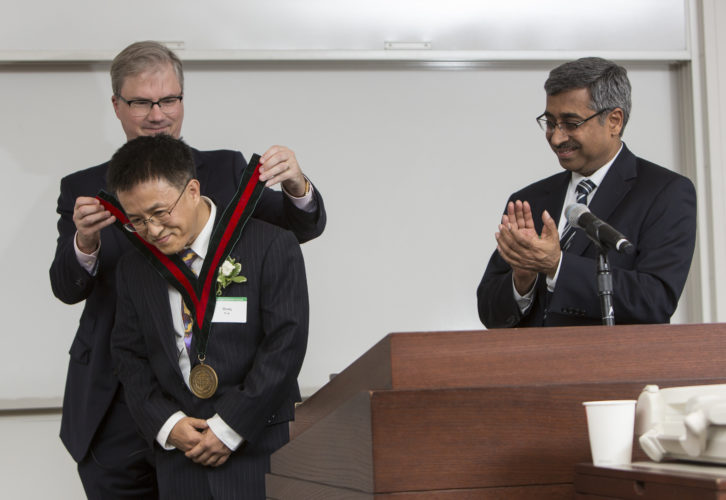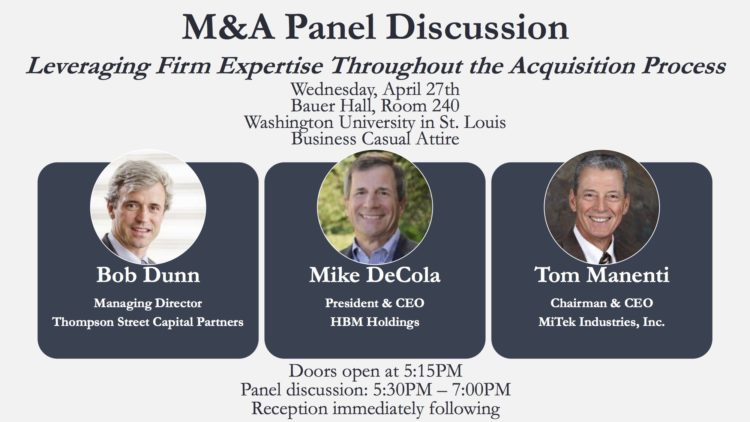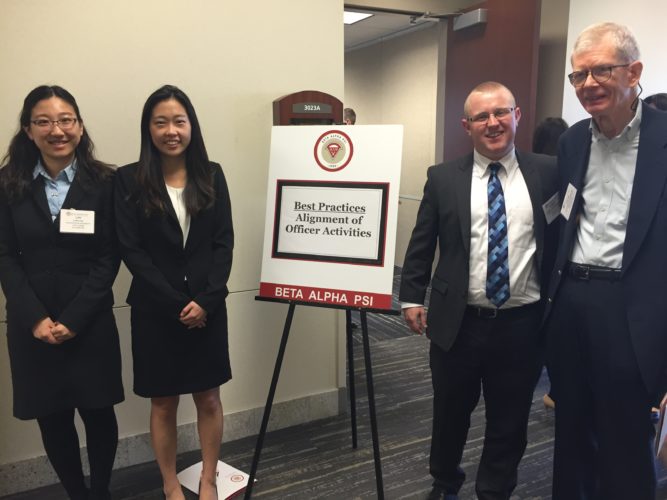Hong Liu, professor of finance and director of the master’s in finance program at Washington University in St. Louis’ Olin Business School, has been installed as the Fossett Distinguished Professor. A celebration to mark the occasion was held May 6 at the Charles F. Knight Executive Education & Conference Center.
Liu, whose research focuses on asset pricing and market microstructures, has served as a member of Olin’s faculty since 1998.
The professorship was made possible by a commitment in 1996 from Olin alumnus and world-renowned adventurer Steve Fossett. Steve, who served as a Washington University trustee, died in a plane crash in 2007.
“I am deeply grateful for the Fossett Distinguished Professorship and for the opportunity to remember Steve’s many contributions as a dedicated alumnus and generous benefactor,” Chancellor Mark S. Wrighton said. “I also wish to thank Peggy for her ongoing support. As we all continue to push the limits of academic excellence and personal achievement, we can be assured that Steve’s legacy lives on at Washington University.”
“We are pleased to recognize Professor Liu’s many accomplishments, and all that he has done for Olin Business School and its students with this prestigious position,” Provost Holden Thorp said. “He’s a leader in his field, he’s a leader at Olin, and we’re fortunate to have counted him among our faculty for the past 18 years.”

Liu earned his bachelor’s degree from the University of Science and Technology of China in 1987; master’s degrees from Shanghai Jiao Tong University in 1990 and the University of Connecticut in 1994; and his doctorate from the University of Pennsylvania in 1998.
His research interests are primarily in optimal investments and asset pricing in markets with frictions. On the topic of portfolio choice with transaction costs, he is one of the most prolific authors in terms of publications in top finance and economic journals. He and his co-authors are the first to explain some long-outstanding puzzles, such as why bid-ask spreads can decrease with information asymmetry and why investors may under-diversify.
Liu’s recent research topics include why short-sale constraints may decrease equilibrium prices and why portfolio re-balancing can potentially explain the well-documented disposition effect – that is, why investors tend to sell winners and keep losers.
Liu has served as a referee for leading journals in the finance field, including the American Economic Review, Journal of Economic Theory, Journal of Finance and Review of Financial Studies. Currently, he is an associate editor at Management Science and Review of Finance. Liu also serves as an academic director on the board of directors of the Midwest Finance Association, and as an academic director of the Master of Science in Finance program at Olin Business School. He has consulted for various organizations, as well as written dozens of research articles and lectured at universities around the world.
About Steve and Peggy Fossett

Steve Fossett
An accomplished adventurer and successful businessman, Steve Fossett earned a bachelor’s degree in economics from Stanford University in 1966 and went on to attend Olin, where he earned an MBA in 1968.
He began his professional career in computer systems with IBM before entering the world of the commodities broker, first with Merrill Lynch and then for himself. He founded and managed Lakota Trading Inc., and was a member of the New York Stock Exchange for 26 years.
While he made his mark on the business world, specifically in the field of investments and commodities, Fossett achieved global attention as a record-setting aviator, sailor and adventurer. The holder of official world records in five sports — balloons, airships, sailboats, gliders and jet airplanes — Fossett was perhaps best known as the first person to fly around the world alone, nonstop, in a balloon. He was declared dead in 2008, five months after his small plane vanished over the Nevada desert. He was 63.
A committed leader and generous supporter of Washington University, Fossett served on the university’s Board of Trustees and on Olin’s National Council. In addition to establishing the Fossett Distinguished Professorship, he and his wife, Peggy, provided funding for the Fossett Pathfinder Fellowships for undergraduates studying environmental sustainability and for the Fossett Laboratory for Virtual Planetary Exploration. He received the university’s Olin Business School Distinguished Alumni Award in 1995 and an honorary doctor of science degree from the university in 2006.
Peggy Fossett is a native of St. Louis and an alumna of Webster University, where she earned a bachelor of arts degree in 1966 and later served as a member of the board of trustees. At Washington University, she has continued her husband’s legacy of philanthropy. She is a life member of the Danforth Circle Chancellor’s Level of the William Greenleaf Eliot Society and has made generous contributions through the Peggy and Steve Fossett Foundation in support of Antarctic research and the Department of Earth and Planetary Sciences.
Guest Blogger: Erika Ebsworth-Goold
Photos by Jerry Naunheim Jr.





 In the afternoon, we went to
In the afternoon, we went to  (Director in US Public Finance), and James Fielding (Senior Director in Corporate and Government Ratings).
(Director in US Public Finance), and James Fielding (Senior Director in Corporate and Government Ratings).






 The Regional Conference began with keynote speaker Alexi Wellman, Vice President of Finance at Yahoo! who provided students with insights on the value of taking risks and creating opportunities for oneself. The three students and the faculty advisor had the opportunity to network with 157 students from 17 other colleges and universities and Professional Partners from several accounting and professional services firms.
The Regional Conference began with keynote speaker Alexi Wellman, Vice President of Finance at Yahoo! who provided students with insights on the value of taking risks and creating opportunities for oneself. The three students and the faculty advisor had the opportunity to network with 157 students from 17 other colleges and universities and Professional Partners from several accounting and professional services firms.
